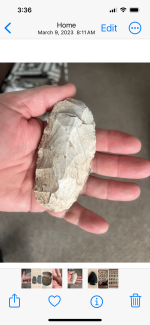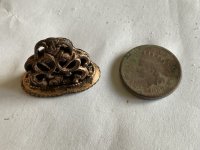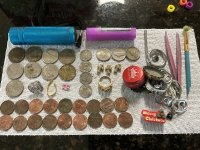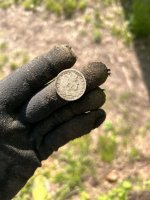- May 20, 2004
- 1,721
- 152
- Detector(s) used
- Minelab Excal 1000
- Primary Interest:
- All Treasure Hunting
Search for John Paul Jones' ship
By BERT HOUSTON, For The Capital
Where best-selling author Clive Cussler failed on at least five occasions, a soft-spoken underwater archaeologist from the Annapolis area is optimistic about success.
Bob Neyland, who lives in the Bay Ridge area and supervised the recovery of the American Civil war submarine Hunley on Aug. 8, 2000, is set for a special project.
He plans to find Bonhomme Richard, the battleship that sank under swashbuckling Scottish sailor John Paul Jones as he uttered the famous words: "Surrender? I have not yet begun to fight."
Despite the 1779 sinking of his ship on the Yorkshire coast of England, Mr. Jones is a hero in the United States. Regarded as the father of the U.S. Navy, the sailor boarded and took over the vastly superior English warship Serapis.
But despite several searches - including a number carried out by Mr. Cussler between 1978 and 1996 and another now under way - the wreck of the Bonhomme Richard has never been found. The ship was put at the disposal of Jones, then a captain in the American Continental Navy, by King Louis XVI of France.
Now 54-year-old Mr. Neyland, head of the underwater archaeology branch of the U.S. Navy Historical Center in Washington, is preparing a team for an underwater search. The three-week hunt, led by the Ocean Technology Foundation, the University of New Hampshire and the UK Hydrographic Office, begins next month.
At the head of the search is a privately owned British Survey vessel, Mr. Neyland said.
"We came up with the idea that perhaps one way to go about it would be to take the last historical information for the locations and put that with the weather and tide information from historical records and use modern computers to create a predictive model ofwhere the ship went down," he said.
"Coupling a drift model technology with what's called geographical information systems, the charts, wreck lists, snags and hangs, and being able to put everything together into one computer program enables you to better recognize patterns."
But predicting where the wreck is located is just the beginning.
"We also know there are many, many wrecks out there, especially from World War I and World War II, so we have to sort out the Bonhomme Richard from all the other wrecks, and again this GIS system will help us do that.
"We may be able to further define our predictive modeling, not only for the area where the wreck went down, but also for what type magnetic and sonar anomaly would be most indicative of the one we want."
He admits that they're not likely to find the name Bonhomme Richard on the wreck, but he thinks they can find cannons or cannonballs from that period, or small arms.
Other artifacts that fit the time period and the military nature will help to narrow the search.
"A lot of archaeology for this time period is circumstantial at first - you find more and more bits and pieces of evidence that begin to indicate it is the right ship and sometimes you get really, really lucky. You (might also) find a pewter tankard or something that has JPJ or some initials on the bottom from some officer or crew members we know the name of."
The condition of the wreck will depend a lot on the nature of the sea bottom where it came to rest. Mr. Neyland said the some items on the ship - leather, textiles, and organic things that usually don't preserve on land - could still be in good condition.
And of course, cannons, cannonballs and the heavy ballast of iron the ship was carrying would be well-preserved.
The next phase will put searchers in up to 200 feet of water.
"We would take all the data and analyze it and pick out for next year the magnetic or sonar anomalies that look promising," Mr. Neyland said. "Then go back with something like a multi-beam sonar, which is high-resolution and three-dimensional, and then also maybe use remotely operated vehicles to actually dive the site and record them with video and sonar as well."
Once everything has been recorded, divers would be sent back down and all necessary permits would have to be acquired. Mr. Neyland will also have to work with France, England and the U.S., all of whom have an interest in the wreck.
"Usually in these things you always prepare for a multi-year, multi-phase project," he said. "Everyone hopes to be lucky and it always pays to be lucky, but usually these things take time."
http://www.hometownannapolis.com/cgi-bin/read/2006/06_22-03/TOP
By BERT HOUSTON, For The Capital
Where best-selling author Clive Cussler failed on at least five occasions, a soft-spoken underwater archaeologist from the Annapolis area is optimistic about success.
Bob Neyland, who lives in the Bay Ridge area and supervised the recovery of the American Civil war submarine Hunley on Aug. 8, 2000, is set for a special project.
He plans to find Bonhomme Richard, the battleship that sank under swashbuckling Scottish sailor John Paul Jones as he uttered the famous words: "Surrender? I have not yet begun to fight."
Despite the 1779 sinking of his ship on the Yorkshire coast of England, Mr. Jones is a hero in the United States. Regarded as the father of the U.S. Navy, the sailor boarded and took over the vastly superior English warship Serapis.
But despite several searches - including a number carried out by Mr. Cussler between 1978 and 1996 and another now under way - the wreck of the Bonhomme Richard has never been found. The ship was put at the disposal of Jones, then a captain in the American Continental Navy, by King Louis XVI of France.
Now 54-year-old Mr. Neyland, head of the underwater archaeology branch of the U.S. Navy Historical Center in Washington, is preparing a team for an underwater search. The three-week hunt, led by the Ocean Technology Foundation, the University of New Hampshire and the UK Hydrographic Office, begins next month.
At the head of the search is a privately owned British Survey vessel, Mr. Neyland said.
"We came up with the idea that perhaps one way to go about it would be to take the last historical information for the locations and put that with the weather and tide information from historical records and use modern computers to create a predictive model ofwhere the ship went down," he said.
"Coupling a drift model technology with what's called geographical information systems, the charts, wreck lists, snags and hangs, and being able to put everything together into one computer program enables you to better recognize patterns."
But predicting where the wreck is located is just the beginning.
"We also know there are many, many wrecks out there, especially from World War I and World War II, so we have to sort out the Bonhomme Richard from all the other wrecks, and again this GIS system will help us do that.
"We may be able to further define our predictive modeling, not only for the area where the wreck went down, but also for what type magnetic and sonar anomaly would be most indicative of the one we want."
He admits that they're not likely to find the name Bonhomme Richard on the wreck, but he thinks they can find cannons or cannonballs from that period, or small arms.
Other artifacts that fit the time period and the military nature will help to narrow the search.
"A lot of archaeology for this time period is circumstantial at first - you find more and more bits and pieces of evidence that begin to indicate it is the right ship and sometimes you get really, really lucky. You (might also) find a pewter tankard or something that has JPJ or some initials on the bottom from some officer or crew members we know the name of."
The condition of the wreck will depend a lot on the nature of the sea bottom where it came to rest. Mr. Neyland said the some items on the ship - leather, textiles, and organic things that usually don't preserve on land - could still be in good condition.
And of course, cannons, cannonballs and the heavy ballast of iron the ship was carrying would be well-preserved.
The next phase will put searchers in up to 200 feet of water.
"We would take all the data and analyze it and pick out for next year the magnetic or sonar anomalies that look promising," Mr. Neyland said. "Then go back with something like a multi-beam sonar, which is high-resolution and three-dimensional, and then also maybe use remotely operated vehicles to actually dive the site and record them with video and sonar as well."
Once everything has been recorded, divers would be sent back down and all necessary permits would have to be acquired. Mr. Neyland will also have to work with France, England and the U.S., all of whom have an interest in the wreck.
"Usually in these things you always prepare for a multi-year, multi-phase project," he said. "Everyone hopes to be lucky and it always pays to be lucky, but usually these things take time."
http://www.hometownannapolis.com/cgi-bin/read/2006/06_22-03/TOP







